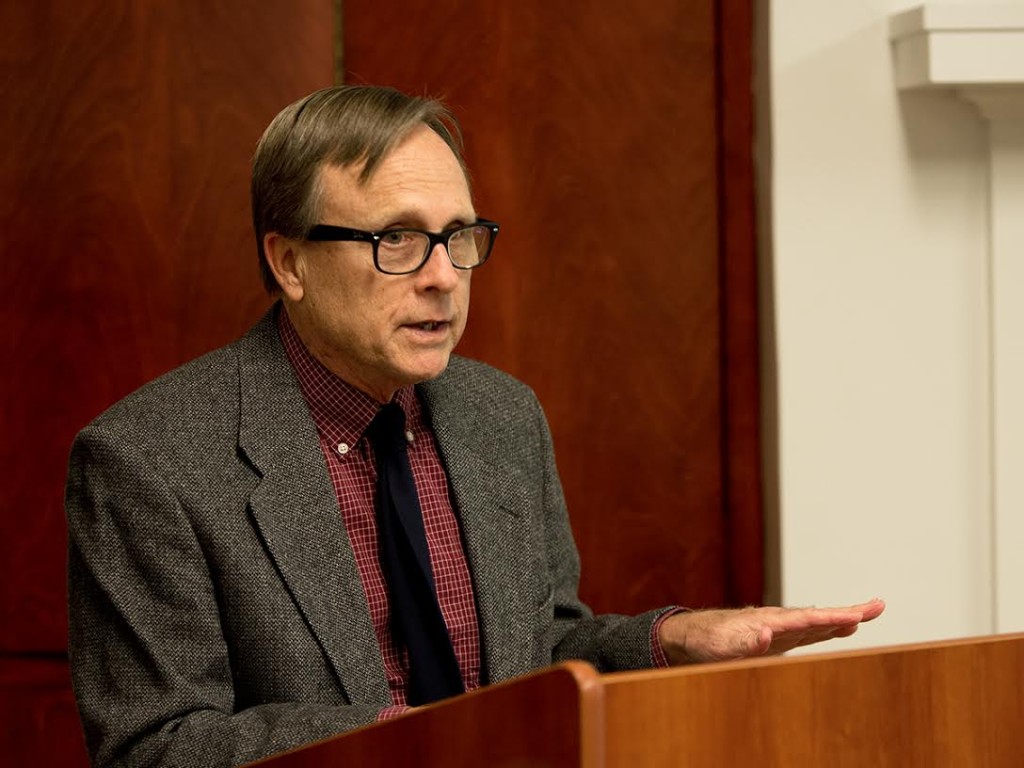
Every winter, interested students and professors unite in the charming, slightly forested Center for Ideas and Society at UCR for the Emory Elliott Book Award. The event was named after former American literature professor at UC Riverside, Emory Elliott, who was also a published author and principal figure within the university’s intellectual community. Georgia Warnke, Director of the Center for Ideas and Society, affectionately remembered Elliott as being “intellectually curious and intellectually generous” and “very inclusive in what he considered good intellectual work.”
Elliott’s enthusiasm for diversity and open-mindedness, contributions to current conversations and furthering scholarly altruism is reflected in the award criteria. “(We don’t choose) the best book that was written, but it’s a book that we believe tells us what Emory was all about,” said Warnke.
This year’s recipient of the award was UCR Professor of Art History Conrad Rudolph. His book, “The Mystic Ark: Hugh of Saint Victor, Art, and Thought in the Twelfth Century,” articulately painted Hugh of Saint Victor’s immensely complex, 42-page text, “The Mystic Ark” (c. 1125) through both literature and art, as seen on the cover of the book, by digital reconstruction. The Mystic Ark, in Conrad’s own words, “is an image of all time, all space, all matter, all history and all spiritual striving.” Because of the “majesty (within the ark) that embraces the cosmos,” and more specifically, the three regions of Earth, Air and Ether, every detail — inscriptions, colors, characters — of the Ark has a meaning. Rudolph proved his point by projecting an image of him pointing at the center of the Ark, the central cubit. It was previously thought, Rudolph informed us, that no single design on the center cross of the Ark can be pointed out due to there being so many, but he proudly proved the historians wrong with the wooden pointer he uses in his everyday lectures.
With the help of projections of the reconstructed Mystic Ark and various other images of the 12th century, Rudolph dissected the Mystic Ark in exceptional detail — so much detail that it could have been overwhelming for non-art history students to process the sentences that were abundant with art history concepts and vocabulary.
After the lecture, Rudolph offered himself for a Q-and-A section. Audience members pitched their questions in such an enthusiastic manner that it would have been any English 1A teacher’s dream to have a classroom with that level of participation. Many of the audience members were likely Rudolph’s own dedicated students (judging from the complexity of their speech and knowledge of the subject) and spoke with a tongue specific to educated, artsy graduate students. Even more, some of the questions sounded more like a lecture in itself — brimming to the top with sophisticated jargon and spoken at a rapid pace. One such audience member, who Rudolph called on as “Chris,” discussed how there were two structural buildings shown in the slides that are referenced to in the Bible — the Ark of the Covenant and Solomon’s Temple — and how they are similar. Rather than asking Rudolph what the similarities could imply, he answered his own question by describing the westward movement of Roman influence across the River Jordan, and that the geographical linkage between the two structures is further proven by the spiritual descendants of Christ shown on St. Peter. Rudolph, not having much to say in response to this comment, built on Chris’ statement by confirming that the proportions of the Ark of the Covenant and Solomon’s Temple are the same and that Solomon’s Temple became a conceptual symbol of spiritual striving in its relation to other structures.
At the very end of the Q-and-A segment, I managed to raise my hand and ask undoubtedly the most simple question of the segment: “What makes art history so important?”
Immediately, Prof. Rudolph’s face softened, and he answered, in a language that I could clearly understand, “Because the world is visual. We live in the most visual society that has ever existed, and we live on the edge of Hollywood. Art history is something that addresses the visual in an academic way, and it is important for people to learn it formally rather than informally.”
Sensing the perfect ending, Prof. Warnke returned to the podium and thanked everyone for attending the reception.
It is true that we live in a visual world. The details, designs and colors that are comprised in art are like letters in a language that people of different cultures can communicate with. It is a language that Prof. Rudolph and I communicated through during the event. While I couldn’t comprehend many of the things he said, I could perfectly understand — by looking at the four arks, the miniscule lamb of the central cubit, the 12 angels of the zodiac and possibly hundreds of other symbols within the Mystic Ark — that art can be used to express stories, history and fascination that words alone cannot communicate.
The Emory Elliott Award pleasantly united literature lovers with the unique backgrounds of the author’s audience, whether they be scholars, artists, historians, travelers and so forth. This year’s award exposed non-art majors to people with a genuine, vigorous passion of art and the possibilities stitched within its eloquent threads. The event will continue to open the eyes of students and professors to the diversity of interests, studies and passions on campus.
And that is exactly what Emory Elliott himself aimed to achieve.








